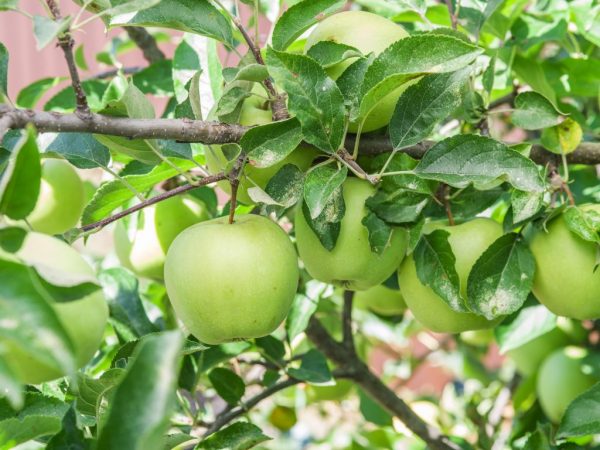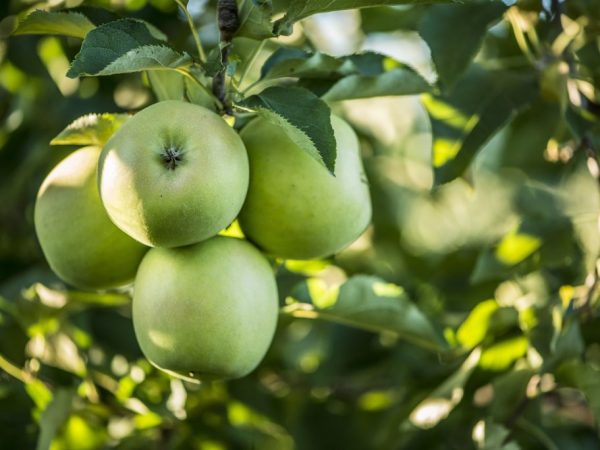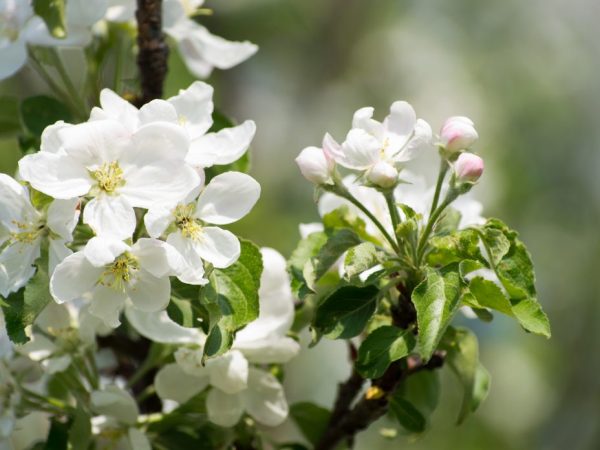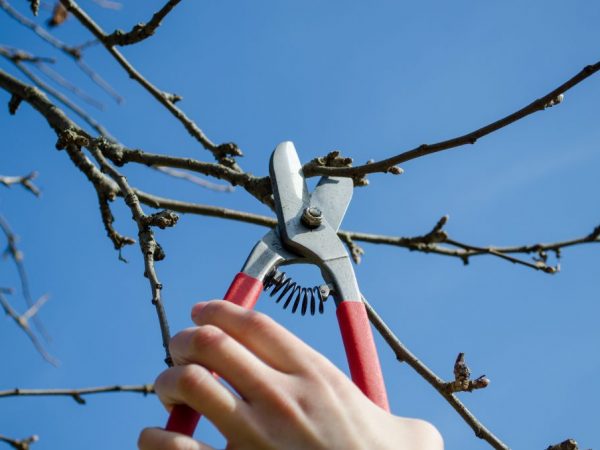Cultivation of an apple tree Oryol Sinap
One of the classic late varieties, the Orlovsky Sinap apple tree, is popular among gardeners. A tall tree tolerates frost without problems. The seedlings bear fruit regularly. From an adult tree, 160-180 kg of fruit can be removed. Sweet and sour large apples are stored for 7-9 months, remaining juicy and tasty.
- Variety characteristic
- Advantages and disadvantages
- Description of the tree and fruit
- Taste
- Benefit and harm
- Yield
- Pollinators
- Winter hardiness
- Disease resistance
- Growing places
- Features of the tree depending on the stock
- Landing
- Timing
- Technology
- Care
- Watering
- Top dressing
- Formation and pruning of the crown
- Protection against diseases and pests
- Features of ripening and fruiting
- Harvesting and storage
- Gardeners reviews

Cultivation of an apple tree Oryol Sinap
Variety characteristic
This type of garden culture was obtained in the middle of the last century by crossing the varieties North Sinap and Pamyat Michurin. The hybrid culture has no specific care requirements. In the first decade of October, you can harvest apple trees.
The fruit is used fresh. They make juices, preserves, jams. Thanks to their dense skin, apples tolerate transportation without any problems.
Advantages and disadvantages
A late-maturing tree has many benefits. The variety has several varieties. Stable yield of apple trees and long-term storage of fruits without deteriorating their taste are the main advantages of the hybrid. Other benefits:
- unpretentiousness of seedlings to care;
- excellent resistance to frost;
- high yields from young and mature trees;
- weak susceptibility to wood scab;
- a wide range of fruit applications.
The variety also has disadvantages. Cons of garden culture: low resistance of seedlings to powdery mildew, large dimensions of the tree.
Description of the tree and fruit
The apple tree Sinap Orlovsky is characterized by the following features:
- powerful tree. Its average height is 5 m. With dwarf rootstocks, the height of the tree is 3 m;
- the wide crown of the garden culture is in the shape of a pyramid. Since it is not prone to thickening, the tree is easy to care for;
- thick strong branches;
- the bark on the trunk and on old branches is gray. The shoots are colored dark brown. There is pubescence on young branches;
- wide, elongated leaves are not very large. They have wavy edges. The color of the leaves is dark green;
- large flowers of the tree are light pink in color.
The weight of the fruit varies from 120 to 200 g. Description: The fruit is rounded-conical, oblong. The top of the fruit is slightly beveled. The fruit stem is short. The skin has a glossy surface.
As soon as the apples are ripe, their dense skin turns yellowish-green. 7-10 days after storage - golden yellow. White subcutaneous dots are clearly visible on the skin of the fruit.
Light green apple pulp. Experts assess the appearance of the fruit at 4.3 points.
Taste
The palatability of the fruit approaches 5 points, but it is not advisable to eat them immediately after being removed from the branches. The percentage of acid in the pulp of the fruit is 1.2-1.5% higher than that of other late varieties of apples.Loose and juicy pulp has a sweet and sour taste. The delicate aroma is poorly expressed.
Having tasted the fruits from the cellar, you will notice that the sourness has softened, and the sweetness in their pulp has increased.
Benefit and harm
Sinap Orlovsky apple pulp contains a high percentage of ascorbic acid (13.7 mg per 100 g). The presence of this vitamin in your body in sufficient quantities will save you from colds, acute respiratory infections, chronic fatigue syndrome and nervous breakdowns.

Fruits contain a lot of vitamin C
During the winter and spring months, when the choice of sources of vitamin C is limited, fruits harvested in the fall will help you fill the deficiency of this substance. These fruits are also useful for other properties:
- one fruit contains approximately 2.6 mg of iron. If your hemoglobin is low, eating apples will help improve your blood composition;
- 100 g of elastic aromatic pulp accounts for 8.9 mg of pectin substances. Pectin relieves constipation and helps cleanse the body of cholesterol. If you experience stomach discomfort, eat raw and baked apples;
- the pulp contains phosphorus, calcium and potassium. These trace elements help to strengthen the heart muscle;
- fruits are moderately sweet. Frequent consumption of apples will not harm the tooth enamel;
- one fresh fruit contains from 70 to 100 kcal (this depends on the size of the fruit). Diabetics can consume a low-calorie treat without risking their well-being;
- the fruit contains fewer dyes than other early maturing varieties. Children's hypoallergenic puree is made from the fruits.
Some people who often consume the fruit have experienced an unexpected deterioration in their well-being. If you suffer from high acidity of the stomach, refrain from eating winter apples, otherwise you may be disturbed by an attack of gastritis.
Unripe fruit should not be given to young children. Otherwise, babies may experience diarrhea.
Yield
In the 4th year after planting, the tree bears fruit. From a young apple tree you will receive 60–80 kg of fruit.
The older the apple tree, the more fruit it can give. Some record trees bear 200 kg of fruit, but generous yields, which last for more than 3 years in a row, drain the crop.
Pollinators
The hybrid has low rates of self-fertility. To get a bountiful harvest from a tree, take care of the presence of pollinators on the site.
The ideal varieties for this for the Orlovsky Sinap apple tree will be Antonovka ordinary and Pepin Saffron. Sometimes gardeners use the Welsey variety as a pollinator.
Winter hardiness
Both young and adult representatives of the variety tolerate temperatures as low as -29 ° C without any problems. Trees on medium dwarf rootstocks are considered the most resistant.
In order for the seedlings to survive the winter safely, cover the near-trunk circle with a thick layer of peat. Humus can be used as a heater.
Disease resistance
One of the indisputable advantages of the variety is its high resistance to pests and diseases. If the summer is damp, the tree can get scab.
Fungal ailments affect an unkempt apple tree. Cutting off sick and frozen branches from a tree, you help it resist diseases.
Growing places
Apple tree seedlings Orlovsky Sinap can be grown in the North-West, Central Black Earth, Central and Middle Volga regions. Winter culture is well cultivated in several regions of Belarus.

Apple needs sunlight
Do not plant trees of this variety in a northern climate. In order for winter crops to delight you with sweet and large fruits, they need to get enough sunlight in late summer and in the first month of autumn. In the North, this is problematic.
Features of the tree depending on the stock
The height of the fruit crop, resistance to pests and frost, and the dessert quality of the fruit depend on the rootstock. Seedlings are more often grafted onto a dwarf stock. Medium dwarf and vigorous plants can also be used.
If a late-ripening garden culture is grafted onto a vigorous young apple tree, the tree height will reach 6-7 m. Thanks to a powerful and well-developed root system, the hybrid seedling will be drought-resistant. A large-sized tree lives 45-50 years.
Be prepared that you will have to wait a long time for the harvest. "Giant" will delight you with fruits for the 6th year after planting. Another disadvantage of a growing apple tree is medium-sized fruits.
In industrial gardens, specimens are often seen grafted onto semi-dwarf rootstocks. A medium-sized apple tree lives on average 40 years. The tree is resistant to pests. It is not difficult to harvest from the branches of a seed crop. The only caveat: fruits may vary in size.
If you are the owner of a small summer cottage, purchase a seedling on a dwarf rootstock. The compact hybrid tolerates the proximity of groundwater better than its tall "brethren". This is because small trees have a shallow root system.
A specimen grown on a dwarf rootstock produces large fruits. The only nuance that may upset you: a low-growing apple tree lives less (20-25 years).
Landing
So that the Sinap Orlovsky apple variety does not disappoint you, take care of the right choice of a place for a seedling. Trees will grow and develop well in fertile loam, sandy loam soil.
The low calcium content in the soil slows down the growth of the tree and reduces the taste of the crop (the apple becomes bitter). The groundwater level should be kept at around 2-2.5 m.
The specimens of winter apple trees are large in size. Make sure that the distance between the variety and other fruit crops is at least 5 m. The presence of pollinators near the tree is a prerequisite for high yields.
Timing
The best time for planting a hybrid in the ground is mid-April. Autumn planting is possible.
If you decide to plant an apple tree on the site in the fall, hurry up to do it before October 16-18. Otherwise, there is a high risk of death of the seedling from early frosts.
Technology
Prepare the pit a month before planting. The depth of the hole should be 80-100 cm. The width of the hole is 90 cm. Remove the sod and fertile soil layer. Remove the infertile part of the soil. Dig up the bottom of the hole. Then put some coarse river sand there. The next step is to lay the sod over the drain.
The soil is mixed with 20 kg of rotted manure, 500 g of ash, 50 g of potassium sulfate and 100 g of superphosphate. The fertile mixture is poured into the hole in the form of a mound. A wooden peg must be driven into the hole.
A young tree is prepared 10-12 hours before planting. Examine it, remove the damaged tips of the roots. Then the tree is soaked in warm water for 8-10 hours. When the roots of the apple tree are saturated with moisture, start planting. Place the tree on a mound. Cover it with earth, lightly tamp the soil. Tie the hybrid to a support.
To make the crown lush and form correctly, shorten the shoots by a third. Then an earthen roller is formed around the tree. Pour 3 buckets of water into the trunk circle. The ground around the apple tree is mulched with peat. Do not untie it from the peg for the first 2 years, even if it seems to you that the seedling is strong and does not need it.
Care

The tree needs good care
Mandatory measures that make up the care of an apple tree: watering, feeding, pruning, protection from diseases and harmful insects. It is necessary to remove fallen fruits from the trunk circle in time.
Watering
Remember the hybrid needs watering. Do not let the trunk circle dry out. A young apple tree is watered 4 times a month. After each irrigation, the soil under the tree is loosened.
Top dressing
The first fertilization is carried out a year after planting. In the spring, when you are digging the soil in the near-trunk circle, apply 600 g of rotted manure under each trunk.
When buds are formed on the branches, 450 g of urea is added. The earth must be carefully dug up.When the crop is harvested, each apple tree must be fertilized with a superphosphate solution.
Formation and pruning of the crown
Without pruning, the crown of the seedlings will form inharmoniously. A year after the Orlovsky Sinap apple trees have been planted, begin to form the first tier. It should consist of 3 sturdy branches. For the next 2 years, form 2 and 3 tiers of the apple tree.
The distance between them should be at least 0.5 m. Curved and weak branches are removed. Shoots growing too close to the ground should be cut. When the center conductor reaches 2.5 m in height, cut it to a side branch.
For adult apple trees, they must carry out spring sanitary pruning. During this event, weak and dry shoots are removed from the tree.
Protection against diseases and pests
Sometimes seedlings become victims of the moth. To drive out insects, spray the hybrids with a wormwood solution.
If the calcium content in the soil is too low, the apples can become bitter pitted. To avoid this problem, spray the tree crowns with preparations containing calcium.
To prevent fungal infections, spray the apple trees with a 1% solution of Bordeaux liquid. This should be done in the spring.
Features of ripening and fruiting
Most varieties of the variety begin to bear fruit in the 4th year. Do not overdo it with nitrogen fertilization of dwarf apple trees. Otherwise, the trees will intensively increase their green mass and yield a harvest one year later than the norm.
A large number of ovaries negatively affects the size and taste of the fruit. In order for the fruits to delight you with their rich taste, remove a third of the buds from the shoots.
Harvesting and storage
October is the time for picking fruit from the branches. Do not rush to pick unripe apples: they are too sour, such fruits are unsuitable for long-term storage. If early autumn frosts occur, they will not damage the crop.
Store apples in a cool place. It is undesirable for them to be in a plastic container for a long time. The best option is cardboard boxes.
At a temperature of 0-4 ° C, the fruits will retain their fresh appearance and rich taste until the end of May. If you place the container with apples in a room with a higher temperature, the product will remain at its best until the beginning of April.
Gardeners reviews
Gardeners characterize the variety positively. The hybrid is unpretentious to the composition of the soil, care. For regions with a cool climate, seedlings are purchased on medium-sized rootstocks.
The trees are resistant to pests and frost. Large and tasty fruits stored for over 7 months are the main reason why the variety has remained in demand for several decades.

